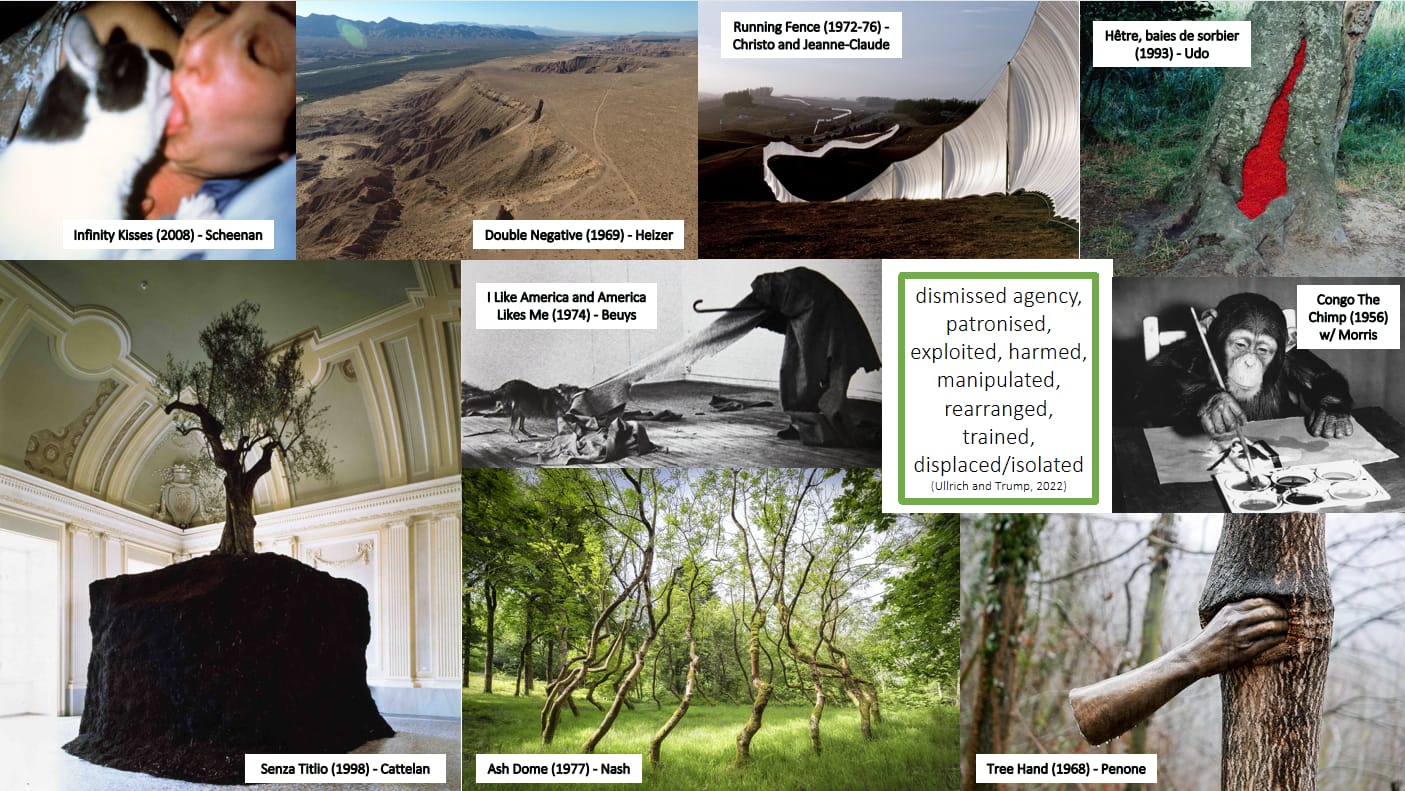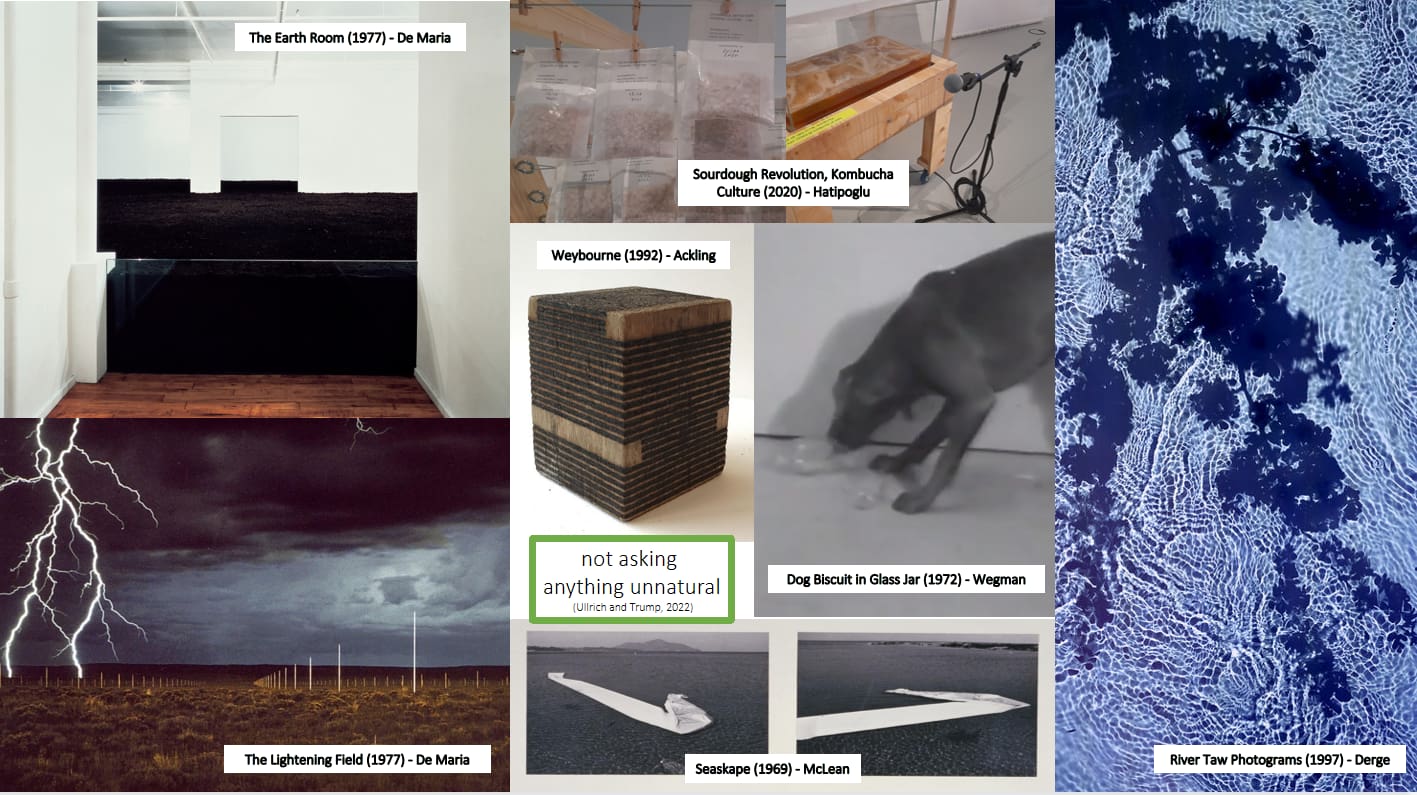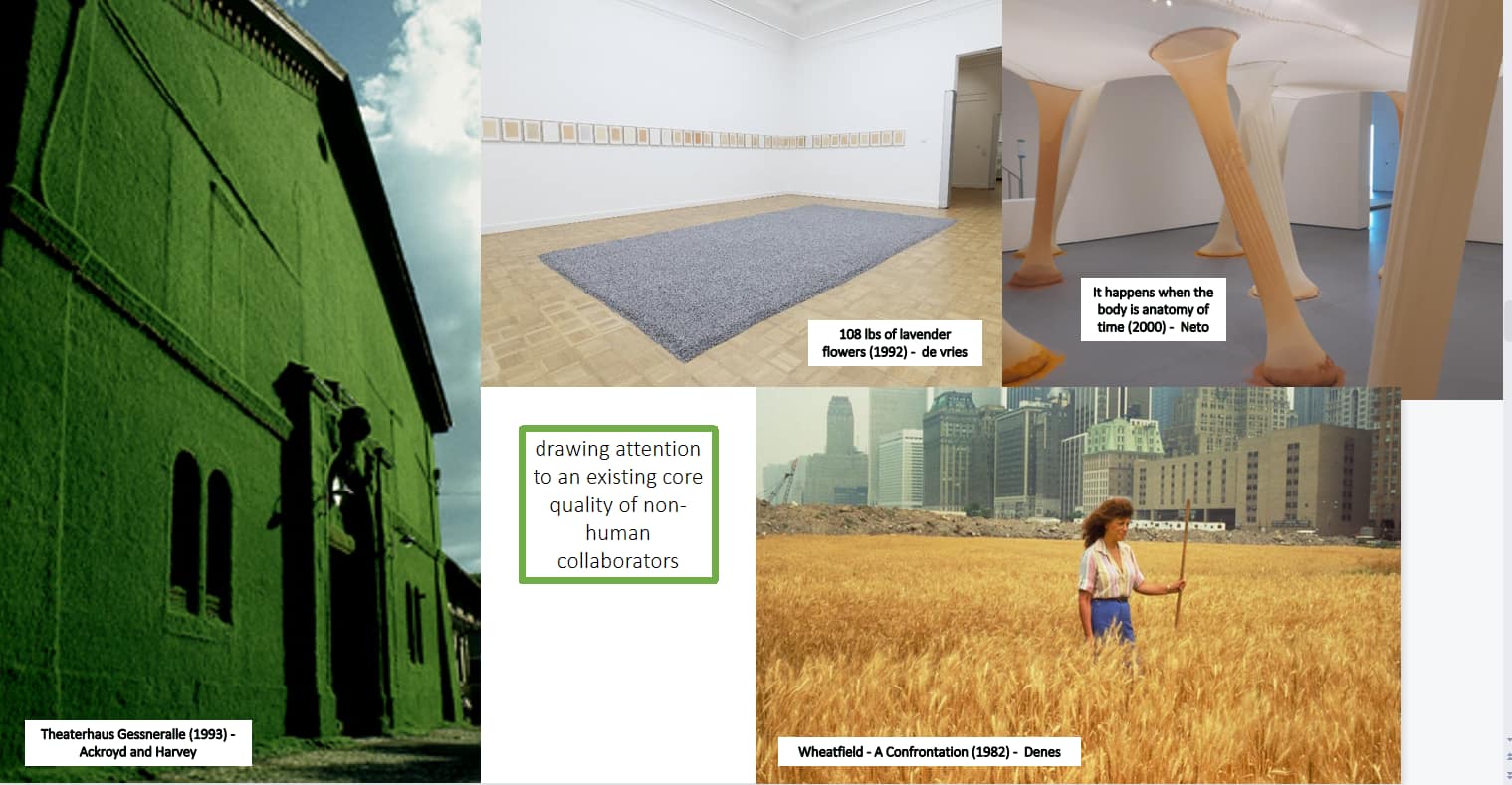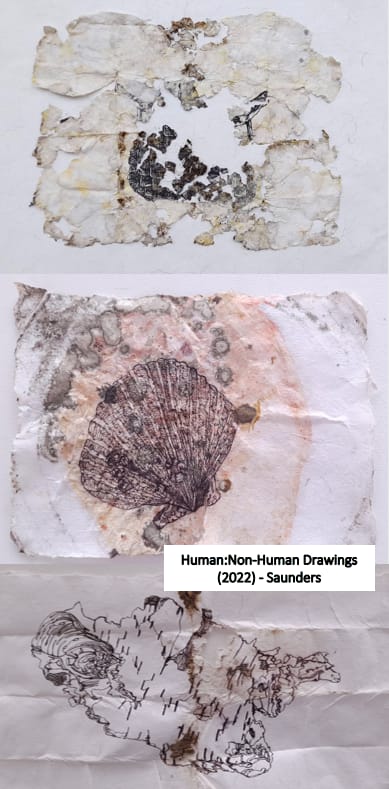Much of the literature surrounding this topic presumes a great deal of prior knowledge about complex ideas relating to philosophy, ethics, anthropology, psychology and geography. The accompanying Glossary summarises some key terms and theories (including, but not limited to, terms used within this paper) in the hope that conversations around this topic may be more inclusive. Bolded text indicates that the term can be found in the Glossary.
Introduction
Despite climate warnings coming as early as the 1890s (History, 2022), 2010-2019 CO₂ emissions broke records as being the highest global decadal growth. Humankind continuously fails to keep temperatures below the +1.5°C damage limitation threshold (IPCC, 2022), leading to decreased biodiversity (WWF, 2020) and life-threatening weather conditions (Met Office, 2022).
I argue – alongside researchers such as Andreyev (2021) and Hernandez (2022) – that to safeguard the survival of all life on Earth (including our own), the exploitative, domineering and reductive Anthropocentric:Global-North:colonial and human-exceptionalist worldview must be dismantled, and replaced with a global, sustainable and empathetic approach that responds better to the needs of the non-human. To achieve this, however, contemporary Western culture must first (re)learn to listen to the Land.
Composed at a midway point of MA study, this paper offers a critique, contextualisation and reflection of my artistic practice in relation to this perspective. Early influences, a previous literature review, and newly-discovered theories and practices are explored before synthesizing and examining the relationships between them and personal creative practice, and how they might influence further artistic research and development.
My Geopoetical, experimental, drawing-based research-practice seeks radical empathy and transformational kinship with the non:human (Saunders, 2022a), through deepening my understanding of non-human ‘languages’, listening to their wisdom and sensitively translating these discoveries ethically and equitably through my own subjective, artistic lens. I have found myself referring to this attentive experience:state of ecological embodied listening as ‘Deep Empathy’, and any cooperative artistic outcomes as ‘Human:Non-Human Creative Collaborations’ (HNHCCs).
Digital manifestations or man-made objects (e.g. equipment) are sometimes included as being ‘non-human’ throughout literature, but within the context of this paper ‘non-human’ refers to natural phenomena that are both physical (e.g. plants, animals, minerals, rivers, mountains, water-earth-fire-wind) or metaphysical (i.e. beings that are supposedly:actually present in nature, e.g. animist spirits, non-living-human souls, or ‘other’).
HNHCCs, therefore, describe a creative union of voice between naturally-occurring entities, one of which must be from a living human. Related literature predominantly focuses on human-animal collaboration, but this paper considers various perspectives, approaches and methodologies for extrapolation into wider human:non-human thinking:communication. I look to inform my creative practice, but also reflect on what it means to be a professional practising artist – and human being – in the face of the climate crisis.

Early Influences
I clearly remember noticing a small bird frantically fighting through a blanket of hardened snow one mid-winter morning, supposedly in search for food. I felt immediately overwhelmed by sadness, concern and frustration, imagining how cold her feet were and how difficult reliable food sources would be. Although I have always had a love for the natural world, it was this singular empathetic encounter in 2017 that significantly recalibrated my personal and creative efforts towards environmentalism. My outlook was later moulded by personal experience, circumstance and philosophy as opposed to any art practice.
My definition of ‘community’ was soon expanded to include plants, animals, soils and waters after discovering Leopold’s Land Ethic (1949), prompting me to challenge my internalised Anthropocentrism into a more sensitive moral code based in interconnectivity and care. Naess and Sessions’ 7 posits of Deep Ecology (1972, cited in Madsen, 2016) offered an early framework for change, whereas eco-feminist philosophy (d’Eaubonne, 1974) introduced me to the parallels between the oppressive, patriarchal:exploitative treatment of both women and the Earth, prompting later contemplation regarding similar parallels to class, disability and race.
Climate activism surged following the 2018 Special Report (IPCC, 2018) – including the Climate School Strikes as instigated by Greta Thunberg (Fridays for Future, 2022), and Extinction Rebellion (Taylor, 2022). My own direct involvement in local activism and national protest around this time were influential in expanding my climate knowledge, facilitating non-hierarchical action and in using creativity for change (Saunders, 2019).
A house move afforded me a small yard, and like many people (Peronne, 2020), I took to gardening during the COVID-19 pandemic. It was an experiential lesson on growing, seasonality, weather patterns, urban wildlife, companion planting, life and decay, cyclicity, balance, collaboration, complexity and the diverse needs of the non-human entities residing in this shared space. It was only later that I acknowledged growing as a valid, experiential form of research that would later directly inform my practice.
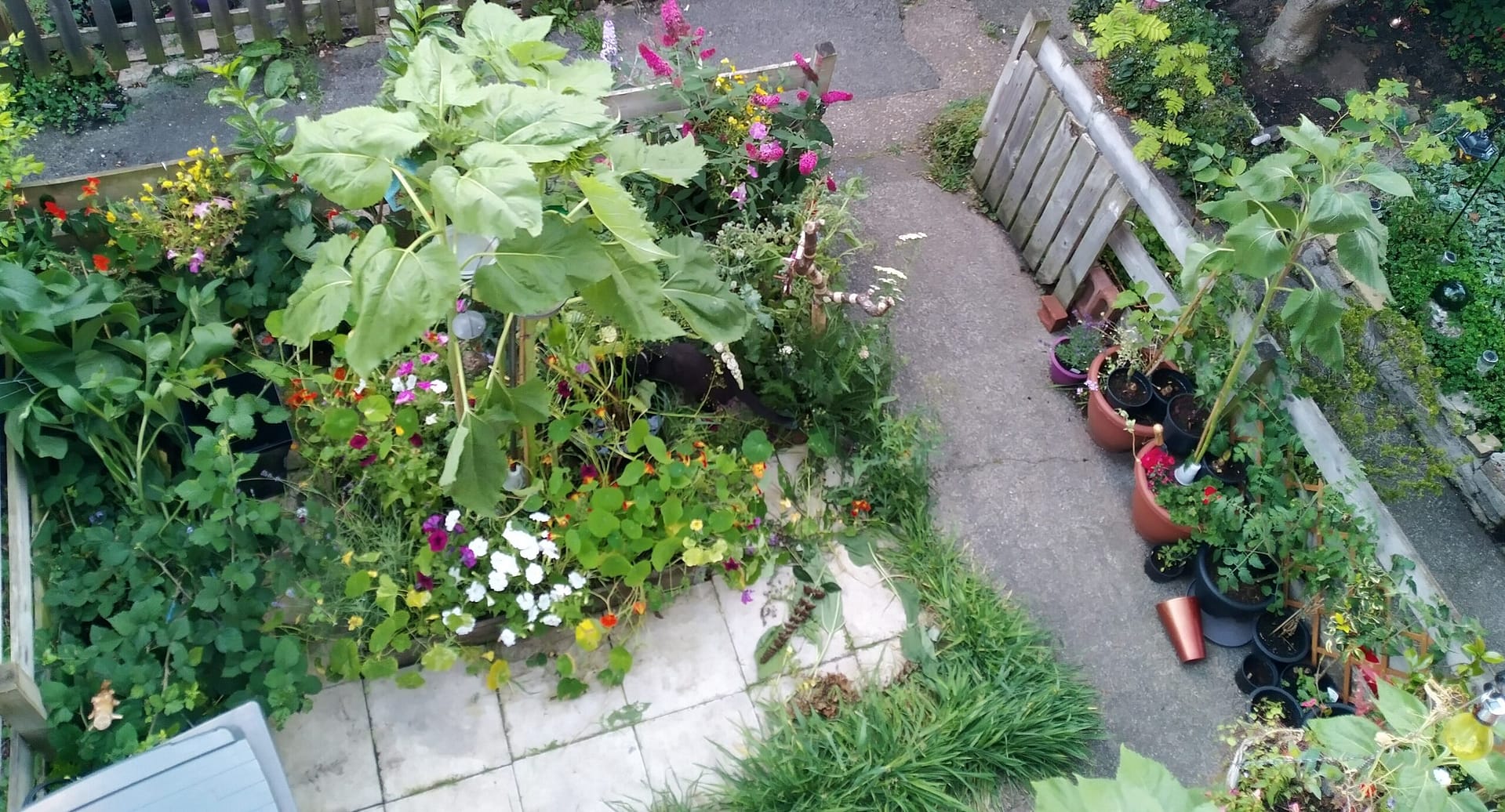
Author’s front garden, Summer 2021
A green-thumbed determination to avoid synthetic chemicals introduced me to practices involved in the Regenerative Landscape Movement, Agroforestry and Permaculture, and practitioners such as Mollison, Holmgren, Liu and Longboat. The tenants of Permaculture design centres on a care for people, a care for Earth, and an equitable sharing of resources (Taylor, 2019). This resonated with my political outlook, yet was still influential in my thinking; in observing and interacting with eco-systems before intervening, in ‘hearing’ and learning what the landscape needs, and introducing concepts such as eco-mimickry, commoning and kemitism.
Growing also introduced me to Lunar Planting (a geotrophic and folkloric system of agriculture based on lunar phases (Almanac, 2022) and herbalism, leading eventually to contemporary Green witchcraft (Murphy-Hiscock, 2017) and occultism. The most influential school of thought for me, in terms of developing my inner sense and learning techniques in communicating with the (meta)physical non-human, has been a free-to-access ‘practical Western esoteric magical training course’ called Quareia, founded by occultists McCarthy and Archer (McCarthy, 2022). In searching for more information about Geomancy (earth divination) I accidentally encountered Geopoetics (White, n.d). It offered a theory-practice that consolidated all my interests and concerns and has since provided stepping stone into broader research and an evolving interest in HNHCCs.
Research impacting on Author’s Practice
Summary of author’s Literature Review titled ‘The Geopoetics of Drawing’
Geopoetics, the biocentric lens through which my work is explored, is an ‘active’ and route-finding creative theory-practice. It expresses itself as geography, space, place and/or landscape creatively, scientifically, philosophically, emotionally and/or spiritually, in pursuit of a radically renewed self, culture, society and human-nature relationships (Bell et al, 2020, p.2; Brownlow, 1978, cited in Ryan, 2020, p.104; Golańska and Kronenberg, 2020; Madge, 2014; Magrane, 2021; Magrane et al, 2020; White, n.d).
Direct Experience is key to Geopoetics, as being of:in:with nature is crucial in hoping to understand and physically:imaginatively entangle oneself with the non-human (Alaimo, 2020, cited in Coleman, 2016, p.88; Bachelard, 1958; Lowenthal, cited by Magrane, 2015. p.87-88; White, n.d.). This focus shared with the psychological field of Nature Connectedness (Lumber et al, 2017), although physical embodiment is not the only way to connect with nature. Magical/shamanistic practice are also considered a metaphysical form of direct experience, where overlapping consciousnesses are acknowledged through symbolic:manifested relational development between practitioner and the natural-world aspects (Morgain, 2013).
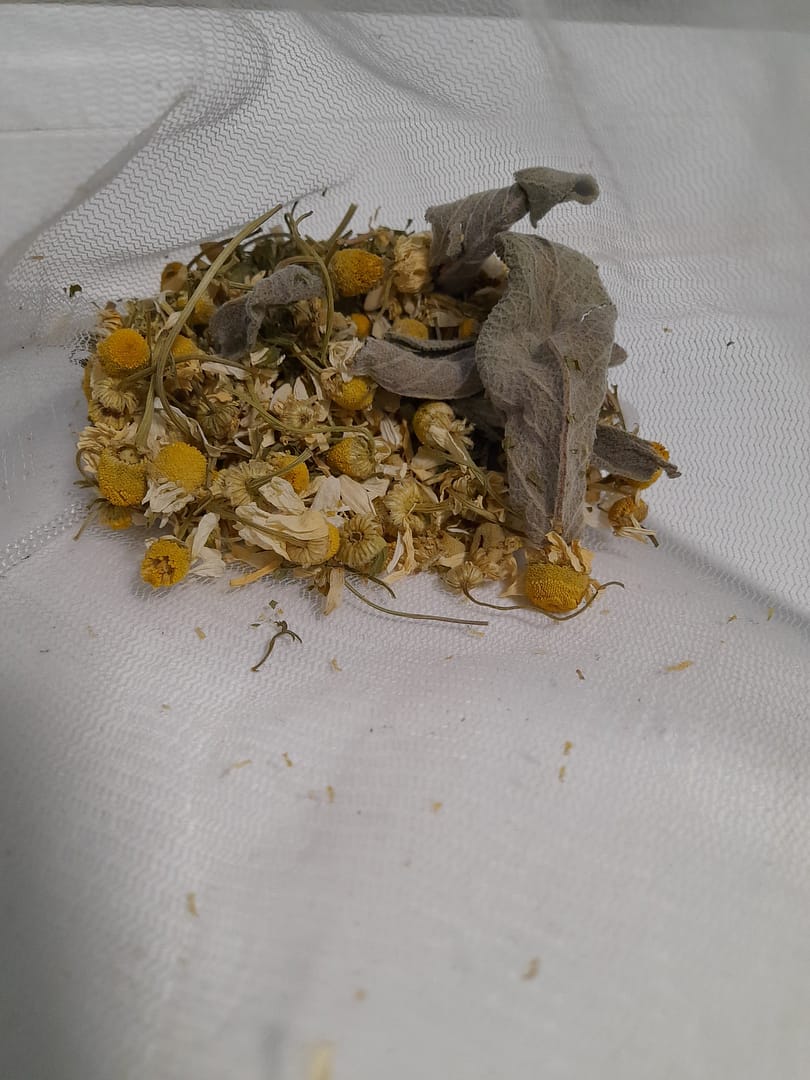
Magical Herb Bag
Communication is central to HNHCCs. A panexperientialist ‘philosophy of organism’ describes a synthesis of mind and matter between object and viewer, resulting in what we understand as perception (Whitehead, 1929, cited by Sjöstedt-H, 2016). Similarities can be drawn with consciousness-enactment philosophies (where subjects can grant access to and communicate with a ‘reader’ in the first person) (Caracciolo, 2014, cited in Ryan, 2020, p.112), and the Navajo belief of ‘the mind’ as a participatory wind (and a source of shamanistic gift) rather than a personal possession (Abram, 1997)
Regardless of how we connect:communicate, once we acknowledge the non-human as being independent, active, co-creators of knowledge (Barrett, 2014, cited in Golańska and Kronenberg, 2020 p.307), HNHCCs not only become a hotbed of creative-philosophical possibility (Magrane, 2015) but could develop revolutionary respect for other species (Jevbratt, 2010, cited in Ryan, 2020, p.111). Non-human empathy develops from this ecoliterate transformation, from which moral duty, action, and a sensitivity to the needs of the Earth arises (Alaimo and Hekman, 2008, cited in Coleman, 2016, p.88; Kim, 2016).
Drawing encourages looking deeper, and as such, nature-based markmaking supports eco-sensitive geopoetical theory, embodied practice and ecoliterate learning as a meaningful methodology of developing an awareness, connectedness, kinship and a sense of heightened moral duty towards the Earth.
Eco-literate art is existentially and spiritually transformative for both artist and audience, and the ethical development, creation and sharing of artwork can help to unpick centuries of Western anthropocentric thinking. Taking a decolonised approach is vital in understanding how Indigenous:traditional perspectives on kinship offer more sustainable visions of the future. Developing a kinship with the Earth is central to the spiritual, emotional, existential, material, scientific and creative transformation on which our survival depends, and an integrated ‘both:and approach’ amongst the interwoven pathways of direct (physical and metaphysical) experience of Nature, the sciences, and the arts is how this meaningful change takes place (Saunders, 2022b).
Newly influential theory and artistic practice
Whilst non-human beings have been creatively acknowledged, it is typically to use them as material or symbolic interfaces to produce something reflective of the ‘artist’s intentionality, intuition and interpretation’ (Cypher, 2017). Live animals appear ‘primarily as muse, motif, material, model and medium’, ‘consumed as exhibition pieces, manipulated as objects of study or pure spectacle, rendered as material or anthromorphised’ (Ullrich, 2019). They may also experience captivity:restraint:control, use human tools when ‘working’ in human environments, or made to engage in human behaviours without understanding the human context. In this way, non-humans frequently have their creative agency dismissed, anthropocentrically patronised or manipulated by artists (Ullrich and Trump, 2022).
Examples in practice which are indicative of how artists seek to ‘control’ nature include Schneeman’s Infinity Kisses (2008) – in which she french-kisses her cat, Beuys expressing his own political anxieties by trapping a coyote in an art gallery for I Like America and America Likes Me (1974), and Morris’ anthropocentric training of Congo the Chimp (1956-57). Non-human control seems to take one of three formats: a) rearranging/training/manipulating the non-human in pursuit of human-centric aesthetics – such as with Land Artists Goldsworthy, Udo, Nash and Penone, b) to aesthetically displace:isolate entities – for example Cattelan’s Senza Titlio (1998), or c) do both, such as in the example of Christo and Jeanne-Claude’s Running Fence (1972-76) and Heizer’s Double Negative (1969), which hold ecosystems to ransom by cutting across the landscape. All of these, in my opinion, fail to ethically centre the experience/voice of the non-human, despite many purporting to argue for environmentalism.
However, there are some Interspecies Artists that involve animal participation by framing natural behaviours – including sitting, staring, singing or colour-transitioning (Deleuze, 1998, cited in Ullrich and Trump, 2022) – or otherwise not demanding anything that is unnatural for the animal(s) involved (ibid.). Wegman collaborates with weimararaners in photography, film and performance (e.g. Dog Biscuit in Glass Jar, 1972), and although not Interspecies Artists, De Maria showcases the energies of natural elements in works such as The New York Earth Room (1977a) and The Lightening Field (1977b). Natural behaviour/process also forms the basis of works such as River Taw Photograms (Derge, 1997-8), Seaskape (McLean, 1969), Hatipoğlu’s Sourdough Revolution, Kombucha Culture (2020) and Ackling’s solar harnessing works (e.g. Weybourne, 1992).
Other artists simply draw attention to a core quality of their non-human collaborators. The tactile, sensory phenomenological showcasing of natural ontologies present in de vries’ 108lbs of lavender flowers (1992) or Neto’s It happens when the body is anatomy of time (2000) offer an embodied opportunity to reconnect with a singular material:entity. A similar experience outside of the gallery space can be found in Denes’ fiercely socio-political activist work Wheatfield – A Confrontation (1982), and architectural grasswork Theaterhaus Gessneralle (Ackroyd and Harvey, 1993).
Interspecies Art should be respectful, discursive, and empowering, where animals are given some agency (including to refuse), engaged with as equal artistic co-creators, whose ‘work’ is valued even though they still might inevitability serve as an anthropocentric, artist-ego-extending tool (Ullrich, 2019). Jevbratt (2009) proposes eco-sensitive collaborative methodologies, such as the use of protocols, limbic resonance, overlapping interference patterns and psychic communication (i.e. telepathy).
Incorporating telepathy as a collaborative tool with ‘animals, nature and otherworlds’ has been embraced since the Fluxus and Conceptual Art Movements, despite methodological instability, unpredictability and long-term unsustainability in practice (Drinkall, 2011). Abramoviç embraces limbic resonance:telepathy; “because of the incredible bonds of nature, you just function as a receiver, and as a sender, of certain energies and it’s actually the most important experience” (Phipps, 1981, cited in ibid. p.155). Barrett et al (2021) argues for the validity of Intuitive Interspecies Communication (IIC), a physical and psychical two-way communicative process informed by ethical protocols defined by Penelope Smith (2004, cited in ibid. p.153). It is embraced amongst some animal studies researchers as a way to achieve a non-oppressive “portrait of shared existence” (Lorimer, 2010, cited in ibid, p.149) and “co-becoming” (Haraway, 2008, cited in ibid).
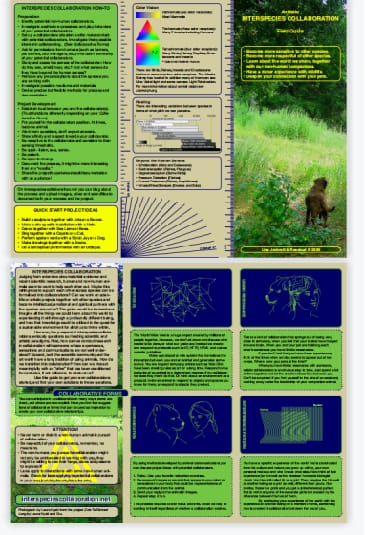
Interspecies Collaboration Field Guide, Barrett
On a more embodied:practical level, Actor Network Theory (ANT) (Latour, 1996;2007; Nickerson, 2022) can be used to consider how the artistic selection of materials/actors may impact knowledge production (Cypher, 2017). ANT explains that supposed human qualities – such as agency, expertise, creative intention, symbolic meaning making or social relations – are entangled with and effected by all preceding influencing non-human actors (Mark, 2017). As humans:artists:researchers, we must not place ourselves at the centre of this network, but rather consider how to best to translate our positionality, power and interconnectivity as a player therewithin (Sheehan, 2011, and May, 2022, cited in ibid. pp.122-23).
In a similar vein of interconnectivity and intra-active agency, the land itself can be considered both an ontological knowledge:memory keeper and a responsive ethical, teacher (Prechtel, 2012, cited in Lange, 2017). Riverspeaking – the process of engaging with this knowing-land – is understood as ‘flowing between process thinking and analytical thinking, living closer to phenomena, becoming conscious of the voices of kin, and actively engaging with cosmic responsibility’ (ibid., p.40). We are all indigenous to somewhere and thus carry its ancient knowledge in our cells, which we can relearn through restorative learning processes (e.g. intuitive attunement, ancient practice, stories, ritual and ceremony). Practice which reflects this notion could include Hesse’s The Witches’ Institution (W.I.) (2022) and Fourthland’s New Land (2015). Regained knowledge acts as a foundation for contemporary cosmic moral and ethical sensibilities that have been buried under Western ontologies and social pressures (Lange, 2017, p.40).
Relationships with Authors Practice
Author’s Work to Date
Typically using natural, biodegradable and/or recycled materials and processes rooted in lived experience, I create drawings, print, sculpture and community participation outcome-based works. However, it has only been within the last year in which my practice has existed within a continuous, deepened and transformational state of performative significance, involving rigorous interdisciplinary research and auto-ethnographical discovery.
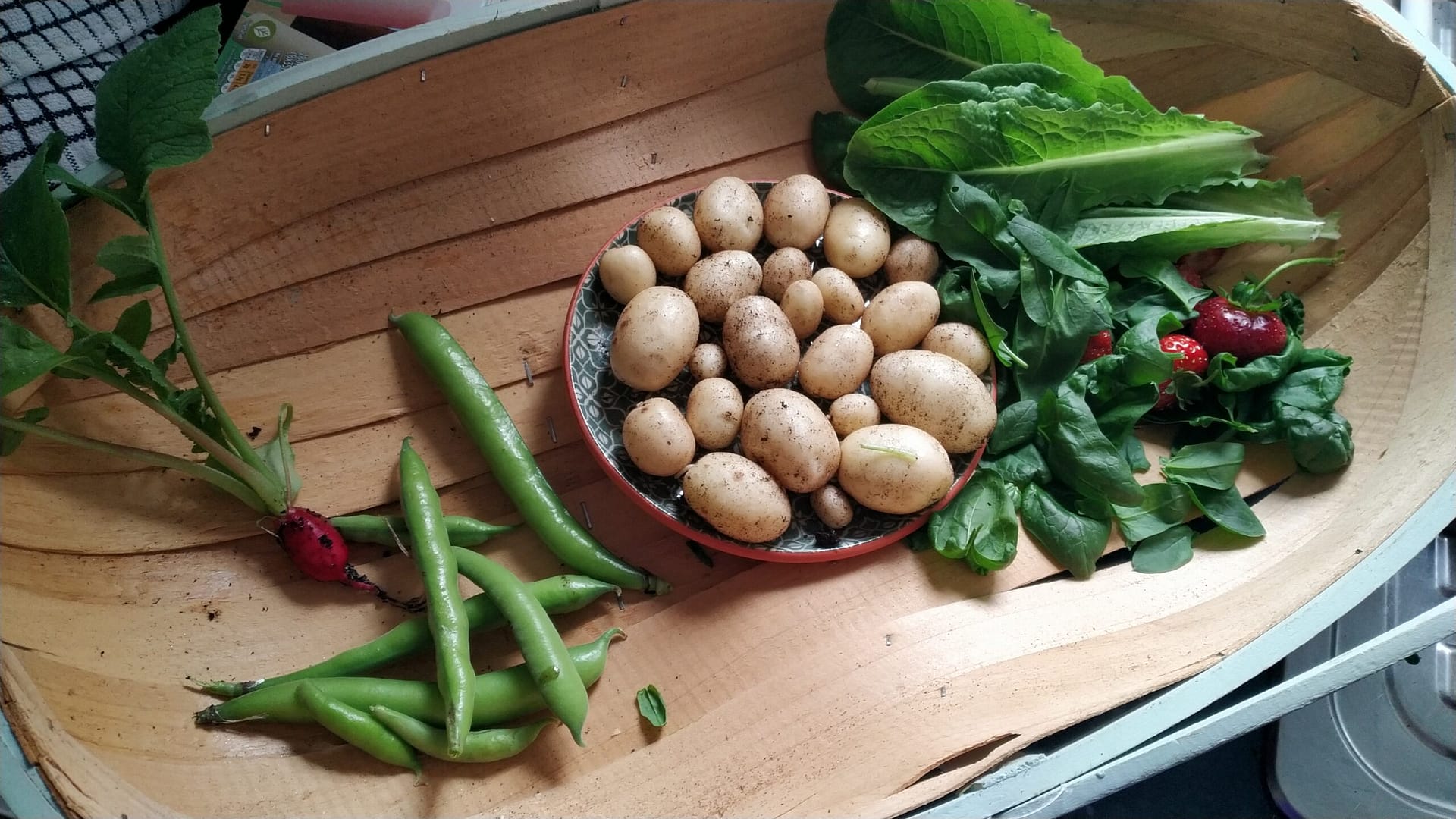
Mid-week harvest, Late Summer 2021
Just as important as any artistic outcome are the space:time interactions (Jokela, 2008) that inform them; growing, foraging and being with nature, as well as ‘listening’ methodologies I employ – observation, meditation, tarot and a deep-seated intuition – and the suggestions I receive. I was recently reminded to be more sensitive with material choices after being psychically(?) reprimanded by a guarded Canadian Maple for using their charcoaled/pencilled kin during a drawing collaboration! It is encounters such as these that increasingly influence my work.
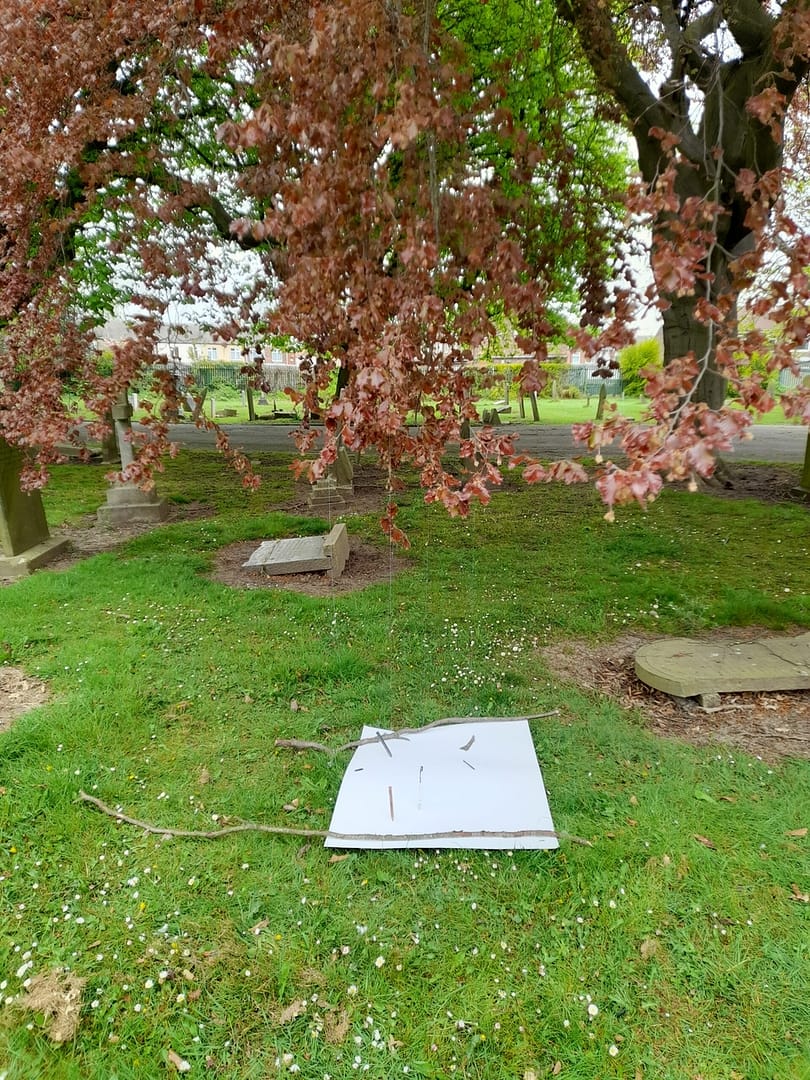
This is where and how the author got ‘told off’ by a Canadian Maple, Spring 2022
Recent key pieces include: Orb Test #1 (2022c), an oversized seed ball that serves as a maquette for a larger-scale, biodegradable, living sculpture from which site-specific flowers bloom; April Tracewalk (2022d), an additative:subtractive conceptual piece that builds upon and inverts the rich tradition of walking in art, and the Human:Non-Human Drawings (2022e), a triptych of drawings that were buried underground, submerged in water and placed at the base of a tree for ~10 weeks. These early test HNHCCs articulated some of the observational:meditative:space:time practices embraced and human:non-human relationships explored throughout my work.
April Tracewalk, Spring 2022
Reflections on theory and practice
If I were to cartographically chart the ‘geographies’ of artistic practice (Hawkins, 2020), Land Ethics, Geopoetics and recognising the non-human as valid co-creators of knowledge continue to serve as my coordinates of ‘creative triangulation’. This is the area my practice inhabits in the pursuit of ecoliterate, personal:audience transformation and action.
Newly discovered literature, however, has provided me with additional landmarks and estuaries from which to navigate, articulate and respond to unresolved, deep-seated concerns, curiosities and inconclusions about how to ethically interact with and represent the non-human in my work. This metaphorical map now also includes a topographical, practice-based spectrum of inspiring vistas to emulate… and exploitative chasms to avoid.
Being human, I cannot deny my influence but I can choose how to serve as a conduit for non-human voices. Actor Network Theory recognises the influence, agency and instrinsic knowledge from said collaborator(s), offering an argument for indirect, ‘second-hand’ creative agency so long as this is ethically translated from ones perspective in the network. This resonates with Caracciolo’s ‘consciousness-enactment’ philosophies, IIC and Jevbratt’s sensitive/respectful methodologies, and, in combination with not demanding unnatural behaviour, would help to counteract any default, anthropocentric positioning of the non-human, further promoting creative agency and equitable participation from non-human co-creators in a greater way than previously achieved.
What struck me whilst critically engaging with the activity of other nature-collaborating artist:practitioners is how unethical I found a majority of them to be – even those which claim to have pro-environmental messaging. I ultimately found this an exercise in what to avoid within my practice, lest I (un)consciously exploit/abuse/oppress my non-human collaborators and/or de-centre:dismiss:manipulate their agency. Practitioners which I relate more to are those who centre the natural, intrinsic qualities of non-human entities by highlighting their naturally-occuring behaviours/processes (e.g. Hatipoglu, de vries and De Maria), and those who use psychic:empathetic inter-being communication as a basis for work (e.g. Jevbratt, Wegman and Abramoviç). I am already adopting similar approaches to these practitioners in my own development of HNHCCs.
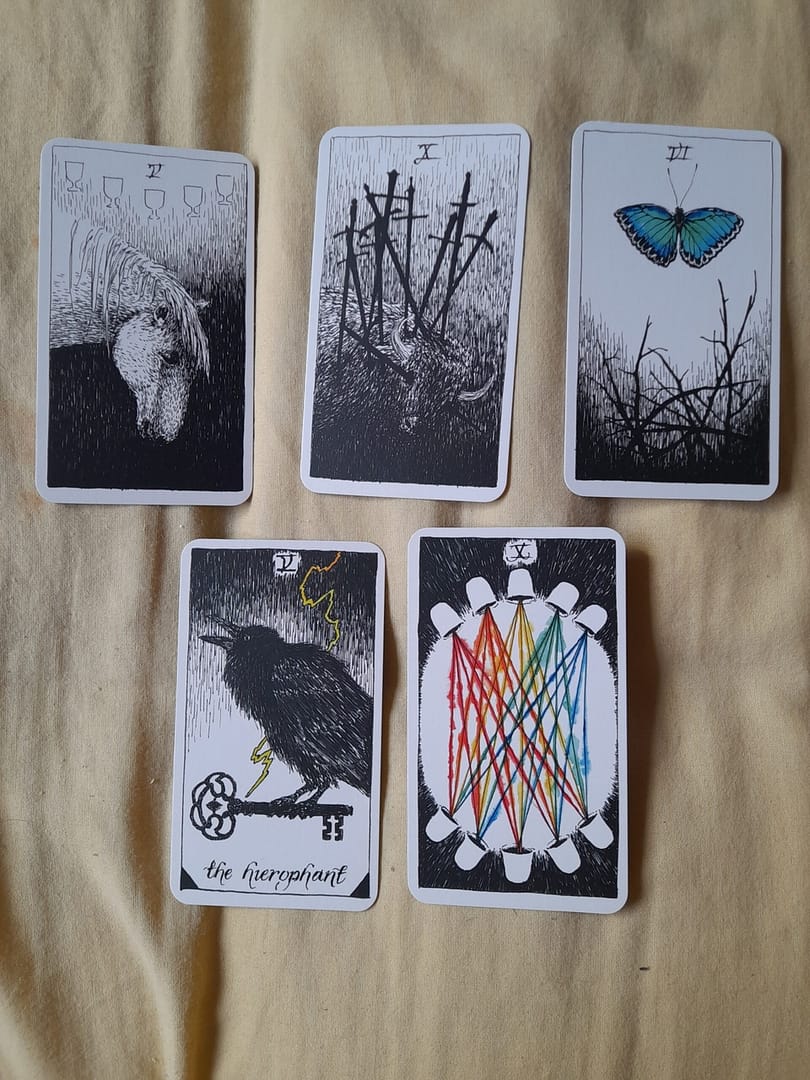
Example of Tarot reading
My practice largely involves intuitive attunement already, so theoretical/practice-based concepts like telepathy, limbic resonance and Riverspeaking appeal to my existing way of working. Most of my intellectual interests and explorative practices so far – growing, Permaculture, foraging, meditating, land-based folklore, herbalism, magick, Traditional Ecological Knowledge (TEK) – are attempts to reconnect with a different way of thinking, and arguably are forms of Restorative Learning.
In summary, the theories, methodologies, practices and frameworks present in this paper build upon and provide context and guidance within my evolving practice.
Creative Development
Prompted by literature and practice, and my particular interest in working alongside earth, plants:trees and seasons (the entities I currently resonate most strongly with), I intend to execute a three-pronged plan of research and development. Firstly, to build on previously explored HNHCC tests in which I buried:submerged:exposed drawings, or grew plants or worked with seasonality, but to make in a way that further incorporates intuition:telepathy:ICC:psychic practices. From these, I would like to develop and share ritual-work and other communicative protocols with audiences, so that they may develop their own human:non-human relationships. This work will focus on celebrating the natural behaviour:process:essence of the entity(/ies) I’m collaborating with. I anticipate that my intentions will soon change, however, when the creative agency of my co-collaborators become more apparent.
Secondly, I plan to keep exploring practices that lend themselves to Restorative Learning, so that I may better understand the ‘voice’ of diverse natural entities and together, develop new ideas for HNHCCs. I intend to build upon my ongoing meditation, Quaeria, permaculture and folkloric growing practices, by beginning to explore land-based Traditional Handicrafts/Skills, Bushcraft and Forest School activities (e.g. whittling, green woodworking, firebuilding) to develop the technical skills that could inspire and inform later HNHCCs.
Lastly, I look to explore accessible ways of sharing my methodologies, so that audiences may find their own ways of (re)connecting, listening and practising more sustainably.
Conclusion
Contemporary practice in which the non-human collaborates as material:co-creator:communicator is broad and varied, and spans:intertwines art, education, spirituality, psychology, agriculture, and more. Yet, despite its socio-politic-historic richness and resonance with indigenous:traditional practices, truly ethical human:non-human collaboration remains on the fringes of Western science, art, culture and politics. This makes it difficult as a practice-researcher to integrate parts of my work into Western notions of ‘research’ or ‘logic’, especially whilst I progress into more unconventional/intuitive ways of knowing. Ultimately, this is arguably reflexive of a widespread, contemporary lack of ‘Deep Empathy’ (which is just as much about being moved to action as it is about listening, understanding or feeling) for the non-human.
Existing literature seemingly overlooks plants, minerals, natural phenomena or ‘other’ entities in favour of human-animal collaboration, possibly because animal biology/feedback is not too dissimilar from our own but also reflective of human:non-human emotional kinship and increasing animal rights. Although other eco-centric practitioners offer guidance on ethical HNHCCs, there are no comprehensive instruction handbooks to follow – possibly because morality is as personal as it is political. However, I have found that taking an interdisciplinary approach – combining philosophy, climate science, TEK and artistic practice – is effective in offering eco-sensitive artists the best frameworks:parameters in which to (re)calibrate their personal moral compass.
As part of an over-arching and mutually beneficial transactional ecology, HNHCCs can contribute to the transformational, sustainable shift in perspective required for sustainable development, not just within artistic practice but in other spheres of human society, as they help reframe the input of the non-human, rebalance power and offer healthier practical solutions in the face of the climate crisis.
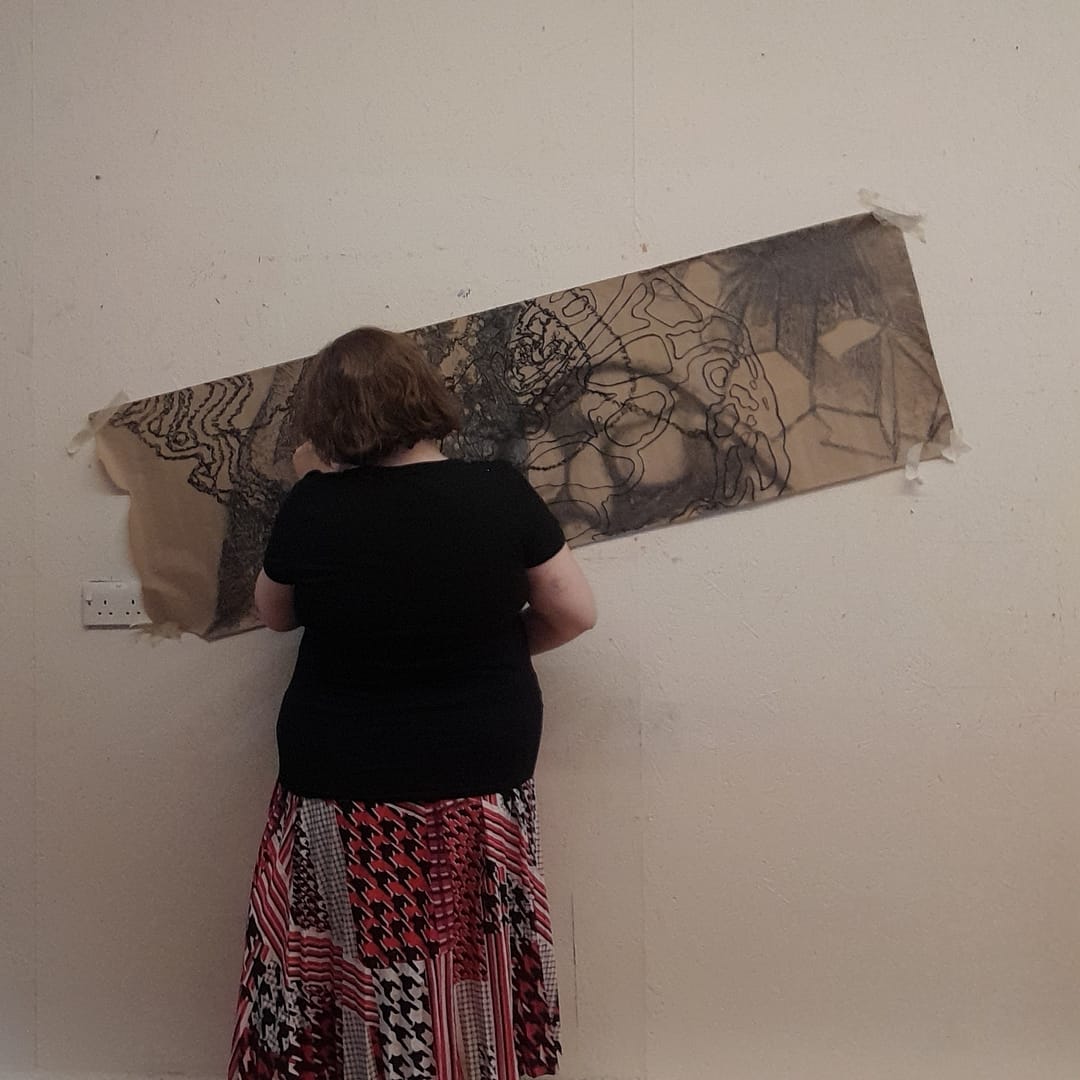
Author drawing
References and Bibliography
|
Abram, D. (1997) Spell of the sensuous: Perception and Language in a More-Than-Human World. New York, NY: Vintage Books. |
| Ackling, R. (1992) Weybourne. [Sunlight on Wood]. |
| Ackroyd, H. and Harvey, D. (1993) Theaterhaus Gessneralle. [Grass wrapped building]. |
| Almanac (2022) [online] Available at: <https://www.almanac.com/content/planting-by-the-moon> [Accessed 7 August 2022]. |
| Andreyev, J. (2021) Uncovering Ecological Understanding and Biophilia through Creative Reciprocity. Bristol: Intellect Books. |
| Bachelard, G. (1958) The Poetics of Space.Reprint, USA: Beacon Press, 1994. |
| Barrett, M., Hinz, V., Wijngaarden, V. and Lovrod, M. (2021) Speaking with other animals through intuitive interspecies communication: towards cognitive and interspecies justice. In: A. Hovorka, S. McCubbin and L. Van Patter, ed., A Research Agenda for Animal Geographies. [online] Elgar Online, pp.149-165. Available at: <https://www.elgaronline.com/view/edcoll/9781788979986/9781788979986.00018.xml> [Accessed 5 August 2022]. |
| Beuys, J. (1974) I Like America and America Likes Me. [Performance, Documentary Photographs, Film]. |
| Cattelan, M. (1998) Senza titolo (Untitled). [olive tree, earth, wood and metal structure]. |
| Christo and Jeanne-Claude (1976) Running Fence. [Heavy woven white nylon fabric (Installation)]. |
| Coleman, V. (2016) ‘Emergent Rhizomes: Posthumanist Environmental Ethics in the Participatory Art of Ala Plastica’, Confluencia,31(2), pp. 85 – 98 |
| Cypher, M. (2017) Unpacking collaboration: non-human agency in the ebb and flow of practice-based visual art research. Journal of Visual Art Practice, [online] 16(2), pp.119-130. Available at: <http://dx.doi.org/10.1080/14702029.2017.1292379> [Accessed 5 August 2022]. |
| De Maria, W. (1977a) The New York Earth Room. [Earth]. |
| De Maria, W. (1977b) The Lightening Field. [Stainless Steel]. |
| de vries, h. (1992) 108 pound of dried lavender flowers. [108 pound of dried lavender flowers]. |
| d’Eaubonne, F. (1974) Feminism or Death.Translated by , Hottell, R. and Merchant, C., 2022. New York: Verso Books (first published 1974,translation in English in 2022). |
| Denes, A. (1982) Wheatfield – A Confrontation. [Wheat]. |
| Derges, S. (1998) River Taw Photograms. [Photograph]. |
| Drinkall, J. (2011) Human and Non-Human Telepathic Collaborations from Fluxus to Now. COLLOQUY text theory critique, [online] (22). Available at: <http://www.arts.monash.edu.au/ecps/colloquy/journal/issue022/drinkall.pdf> [Accessed 17 July 2022]. |
| Forthland (2015) New Land. [Straw, hessian, threads, wax, linen]. |
| Fridays For Future (2022) Fridays For Future. [online] Available at: <https://fridaysforfuture.org/> [Accessed 26 August 2022]. |
| Golańska, D. and Kronenberg, A. K. (2020) ‘Creative practice for sustainability: A new materialist perspective on artivist production of eco-sensitive knowledges’, International Journal of Education through Art, 16(3), pp. 303 – 318. doi: 10.1386/eta_00035_1 |
| Hatipoğlu, A. (2020) Sourdough Revolution, Kombucha Culture. [Mixed media]. |
| Heizer, M. (1969) Double Negative. [Earth]. |
| Hernandez, J. (2022) Fresh Banana Leaves: Healing Indigenous Landscapes Through Indigenous Science. USA: North Atlantic Books. |
| Hesse, E. (2022) The Witches’ Institution. [Mixed Media [Exhibition]. |
| History (2022) Climate Change History. [online] Available at: <https://www.history.com/topics/natural-disasters-and-environment/history-of-climate-change> [Accessed 23 August 2022]. |
| Intergovernmental Panel on Climate Change (IPCC) (2018) Special Report: Global Warming of 1.5ºC. [online] IPCC. Available at: <https://www.ipcc.ch/sr15/> [Accessed 7 August 2022]. |
| Intergovernmental Panel on Climate Change (IPCC) (2022) Sixth Assessment Report of the Intergovernmental Panel on Climate Change. [online] IPCC. Available at: <https://www.ipcc.ch/report/ar6/wg3/> [Accessed 6 August 2022]. |
| Interspecies Internet (2022) Interspecies Internet. [online] Available at: <https://www.interspecies.io/> [Accessed 14 August 2022]. |
| Jevbratt, L. (2009) Interspecies Field Guide. [ebook] Available at: <http://jevbratt.com/writing/interspecies_field_guide.pdf> [Accessed 26 August 2022]. |
| Jokela, T. (2008) ‘A Wanderer in the Landscape: Reflection on the Relationship between Art and the Northern Environment’. In: G. Coutts and T. Jokela (ed.), Art, Community and Environment: Educational Perspectives,1st ed. Chicago: Intellect Press, pp.3 – 27. |
| Kim, J. (2016) ‘Living drawing : Aesthetic teaching for moral artists’, Journal of Moral Education,45(4), pp. 465 – 480. doi: 10.1080/03057240.2016.1239573. |
| Lange, E. (2017) Riverspeaking: the spiraling of transformative and restorative learning toward kinship ethics. [ebook] Wageningen: Wageningen Academic Publishers, pp.33 – 43. Available at: <https://www.academia.edu/33280576/RiverSpeaking_the_spiraling_of_transformative_and_restorative_learning_toward_kinship_ethics> [Accessed 17 July 2022]. |
| Latour, B. (1996). On actor-network theory: A few clarifications. Soziale Welt, 47(4), 369–381 [online] Available at: http://www.jstor.org/stable/40878163 [Accessed 7 August 2022]. |
| Latour, B. (2007). Reassembling the social: An introduction to actor-network-theory. Oxford: Oxford University Press. |
| Leopold, A. (1949) A Sand County Almanac and Sketches Here and There. 1st ed. New York: Oxford University Press. |
| Lumber, R., Richardson, M. and Sheffield, D. (2017) ‘Beyond knowing nature: Contact, emotion, compassion, meaning, and beauty are pathways to nature connection’, PLoS ONE,12(5), pp. 1–24. doi: 10.1371/journal.pone.0177186. |
| Madge, C. (2014) ‘On the creative (re)turn to geography: poetry, politics and passion’, Area, 46(2), pp. 178 – 185. doi: 10.1111/area.12097. |
| Madsen, P. (2016) Deep Ecology. In: Britannica Online. [online] Available at: <https://www.britannica.com/topic/deep-ecology> [Accessed 6 August 2022]. |
| Magrane, E. (2015) ‘Situating Geopoetics’, GeoHumanities,1(1), pp. 86 – 102. doi: 10.1080/2373566X.2015.1071674 |
| Magrane, E., Russo, L., De Leeuw, S. and Perez, C. S. (2020) ‘Geopoetics as Route Finding’. In: Magrane, E., Russo, L., De Leeuw, S. and Perez, C. S. (ed.), Geopoetics in Practice,1st ed. UK, pp. 1 – 13 |
| Marder, M. (2022) Michael Marder. [online] Michael Marder Online. Available at: <https://www.michaelmarder.org/> [Accessed 14 August 2022]. |
| Mark, C. (2017) Unpacking collaboration: non-human agency in the ebb and flow of practice-based visual art research. Journal of Visual Art Practice, [online] 16(2), pp.119-130. Available at: <https://www.tandfonline.com/doi/abs/10.1080/14702029.2017.1292379> [Accessed 17 July 2022]. |
| McCarthy, J. (2022) Quareia. [online] Quareia. Available at: <https://www.quareia.com> [Accessed 7 August 2022]. |
| McLean, B. (1969) Seaskape. [2 photographs, black and white, on paper and typewritten caption on card]. |
| Met Office (2022) How is climate linked to extreme weather?. [online] Available at: <https://www.metoffice.gov.uk/weather/climate/climate-and-extreme-weather> [Accessed 13 August 2022]. |
| Morgain, R. (2013) ‘The alchemy of life: Magic, anthropology and human nature in a Pagan theology’, The Australian Journal of Anthropology,24(3), pp. 290 – 309. doi: https://doi.org/10.1111/TAJA.12052 |
| Murphy-Hiscock, A. (2017) The Green Witch: Your Complete Guide to the Natural Magic of Herbs, Flowers, Essential Oils, and More. New York: Adams Media. |
| Neto, E. (2000) It happens when the body is anatomy of time. [Lycra tulle, clove, cumin, turmeric]. |
| Nickerson, C. (2022) Latour’s Actor Network Theory. [online] Simplysociology.com. Available at: <https://simplysociology.com/Actor-Network-Theory.html> [Accessed 7 August 2022]. |
| Peronne, J. (2020) How coronavirus changed gardening forever. [online] Financial Times. Available at: <https://www.ft.com/content/c3abc0bb-7ade-4ae1-8d2b-d3fa6be53416> [Accessed 7 August 2022]. |
| Ryan, J. C. (2020) ‘Seismic, or Topogorgical, Poetry’. In: Magrane, E., Russo, L., De Leeuw, S. and Perez, C. S. (ed.), Geopoetics in Practice, 1st ed. UK, pp. 101-116 |
| Saunders, L. (2019) Drawing in Between the Lines. The Critical Fish, [online] (2), pp.58-61. Available at: <https://issuu.com/thecriticalfish/docs/fish_issue_2_-_brill_-_web_version> [Accessed 7 August 2022]. |
| Saunders, L. (2022a) Artist Statement. [online] Lauren Saunders. Available at: <https://laurensaundersart.co.uk/artist-statement/> [Accessed 7 August 2022]. |
| Saunders, L. (2022b) The Geopoetics of Drawing. The Critical Fish, [online] Available at: <https://thecriticalfish.co.uk/the-geopoetics-of-drawing/> [Accessed 5 August 2022]. |
| Saunders, L. (2022c) Orb Test #1. [Earth, clay and poppy seeds]. |
| Saunders, L. (2022d) April Tracewalk. [Performance, Cotton, Plastic, Film]. |
| Saunders, L.,(2022e) Human:Non-Human Drawings. [Ink, soil and mould on paper]. |
| Schneeman, C. (2008) Infinity Kisses. [Film]. |
| Sjöstedt-H, P. (2016) The Philosophy of Organism | Issue 114 | [online] Philosophynow.org. Available at: <https://philosophynow.org/issues/114/The_Philosophy_of_Organism> [Accessed 13 December 2021]. |
| Taylor, C. (2019) The Tao of revolution. UK: Stairwell Books. |
| Taylor, M. (2022) The Evolution of Extinction Rebellion. The Guardian, [online] Available at: <https://www.theguardian.com/environment/2020/aug/04/evolution-of-extinction-rebellion-climate-emergency-protest-coronavirus-pandemic> [Accessed 7 August 2022]. |
| Ullrich, J. (2019) Animal Artistic Agency in Performative Interspecies Art in the Twenty-First Century. Boletín de Arte-UMA,, [online] 40, pp.69 – 83. Available at: <https://dialnet.unirioja.es/servlet/articulo?codigo=7229747> [Accessed 17 July 2022]. |
| Ullrich, M. and Trump, S. (2022) Sonic Collaborations between Humans, Non-human Animals and Artificial Intelligences: Contemporary and future aesthetics in more-than-human worlds. Organised Sound, [online] Available at: <https://www.cambridge.org/core/journals/organised-sound/article/sonic-collaborations-between-humans-nonhuman-animals-and-artificial-intelligences-contemporary-and-future-aesthetics-in-morethanhuman-worlds/55E2D18EC60A4BA194AC9F68B2E73801> [Accessed 17 July 2022]. |
| Wegman, W. (1972) Dog Biscuit in Glass Jar. [Film]. |
| White, K. (no date) ‘The Great Field of Geopoetics’ [online] The International Institute of Geopoetics.Available at: <https://www.institut-geopoetique.org/en/founding-texts/133-the-great-field-of-geopoetics> [Accessed 1 December 2021]. |
| WWF (2020) Living Planet Report 2020 – Bending the curve of biodiversity loss. Almond, R.E.A., Grooten M. and Petersen, T. (Eds). [online] Gland, Switzerland. Available at: <https://www.zsl.org/sites/default/files/LPR%202020%20Full%20report.pdf> [Accessed 13 August 2022]. |
